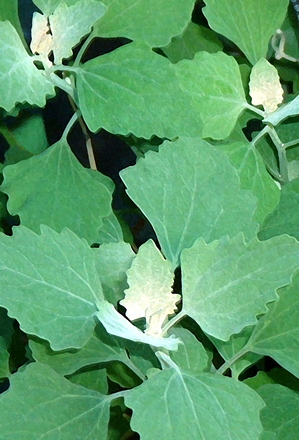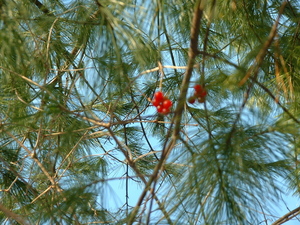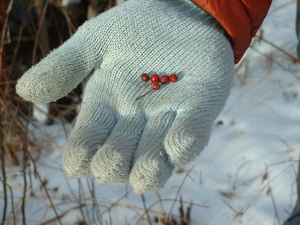Wildcrafting - a lot about seeds and other wild edibles

Close up of spring Lamb's Quarters
Linda Diane Feldt | Contributor
*****
My foraging friend tried cooking up Lamb's Quarter seeds as a grain,
similar to rice. Result: hard, slightly burned. It was lots of work
with not much to be excited about. His next experiment was homemade
whole wheat bread with the Lamb's Quarter's seeds mixed in. The effect
was sort of like poppy seeds, gentle flavor, nice texture, slight
earthiness.
Which reminds me that seeds store better than ground flour. And the taste difference between old flour and newly milled flour is amazing. Fresh flour still tastes alive, not like dust. I've been grinding my own flour with a stone mill for over 30 years. Healthy oils and a lovely nutty taste are saved.
Chenopodium (Lamb's Quarters) are the green pictured at the beginning of this blog. I think they are far better as a green than as grain. The greens can be blanched and frozen for winter eating. I've already eaten what I harvested last spring and summer. A lot of people consider this to be a weed, but it actually has greater nutritional value than many of the plants it is competing with. Eat it as a salad green in the spring.
*****
Early January and my walk in the woods was pre-empted by taking my brother to ER. No wild foods there. Nothing green but scrubs. They didn't ask about diet or herbs. Wild greens are heart healthy - the greener the better. Eat more greens, stay out of the ER. Just my idea for a healthy New Year!
*****
Maple syrup is the first farm crop harvested in Michigan each year. Hoop houses may change that, but the maple syrup season usually begins next month. I'm starting now, saving plastic jugs and identifying trees. Each tap hole provides about 10 gallons sap most years, which can be boiled down to 1 quart of syrup. I plan to tap about six trees.
You can tap any maple, as well as birch and sycamore. The sugar maples are the sweetest. Sap can be used as is or boiled for syrup. If you want more facts on Michigan maple syruping, try this link. Michigan produces over 90,000 gallons of syrup each year. Multiply by 40 to count sap production. It takes 40 gallons of sap to make 1 gallon syrup.
You can drink maple sap or cook with it. I love to make my oatmeal with it. And you can freeze the sap as is to enjoy it later. So you don't have to do all that boiling, although the taste of real maple syrup makes it so very worthwhile.
*****
One of the reasons I like wild and unprocessed foods is that I have some chemical and food sensitivities. Here is a link to my blog about a bad reaction to a cleaning product. So many products are no problem for most people, but for a few of us they can really cause problems.

High Bush Cranberry framed by White Pine
Linda Diane Feldt | Contributor
*****
Found and tasted some High Bush Cranberries out in the woods. Oh, they tasted really truly awful. They have a flat seed and red berry. But the High Bush Cranberry is a great source of vitamin C mid-winter. I tried them the last week in December, and they were the worst ever. I was hoping that time and desperation would improve the flavor.
When I returned a few weeks later, there were just a few berries left. The birds must be hungry. I couldn't reach them to taste, but I did get a nice photo of the few berries that were left, surrounded by white pine.
*****
A winter task. I finally heated and strained five big jars of honey with lots of comb. This was collected when I rescued a wild hive this spring. Big mess, sweet reward. The bees are out in my backyard now, I hope they are warm and snug supporting a healthy queen, waiting for spring. I love that local honey. I had a lot of help with the relocating of the hive, and my foraging friend helped with the straining, in exchange for honey.
*****
In October, I helped glean buckwheat from a patch north of Ann Arbor. It was winnowed (chaff removed) then we ground the seeds in my flour mill with hulls intact. The hulls are then sifted out easily. Foraged buckwheat flour!
We combined that local buckwheat flour with saved acorn flour (it was frozen) and created the ultimate in local foraged/gleaned pancakes. Outstanding. Acorns add a very interesting multi-level taste. The result was pancakes with multiple stories. Handpicked buckwheat with local acorn flour, homemade butter, last year's maple syrup, local eggs, regional raw milk and black raspberries picked over the summer. Wow!
*****
Earlier in the week I found vibrant staghorn sumac fruit bursting with flavor. Glad now we picked it as it rained the next day and that can delete the flavor. In the field, we sucked and licked the berries. My foraging friend took it to make sumacade - soak fruit in cold water, ideal with sun, but time will have to do. Lots of winter vitamin C. My dog Nala found the staghorn sumac berries in my pocket and ate it - the lemony taste made her wince and lick her lips, but she kept nibbling. Wild dog.

Tasty Rosehips found along the Huron River. The flesh is edible, but not the seeds inside.
Linda Diane Feldt | Contributor
*****
Just before Christmas I sampled three different bushes with rosehips while on a walk. The smallest was exclaim-out-loud good. Sweet, lemony, with a nice texture. The other two were bland and bad. The best were less than 1/4 inch, growing by the river. Almost missed them. The yukky hips were more profuse and nearby. You have to taste to know. When I went back a few weeks later, the good ones were gone, the not-so-good were still abundant. I guess the birds figured it out too.
*****
Linda Diane Feldt is a local Holistic Health Practitioner, teacher and writer. Linda Diane offers free classes on wild foods and herbal medicine the fourth Thursday of the month, through The People's Food Co-op. The class on Jan. 28 will be on herbal use for cancer and heart disease, how to make wise and safe choices. For more information on Linda Diane Feldt, her Web site is holisticwisdom.org


Comments
Linda Diane Feldt
Thu, Jan 21, 2010 : 8:56 p.m.
I have heard about that method of making maple syruping go faster. What I was told by a professional was that it can get you further, but that the actual boiling of the sap is essential to obtain the maple flavoring. So you have to boil it some. There is a chemical change that happens only with sustained high temperature as the last part of the process. It is all very interesting.
Spooner
Thu, Jan 21, 2010 : 10:44 a.m.
I learned a trick while making syrup in the 1970s. You collect the sap in the morning while it's frozen. You can lift out the frozen part and throw it away. The bottom liquid contains the sugar. This saves a lot of boiling.
Linda Diane Feldt
Thu, Jan 21, 2010 : 10:40 a.m.
The Lamb's Quarters, Chenopodium, are fairly delicate leaves so I just put them in a strainer, dunk it into boiling water for just a few seconds to blanche them, and then put them in a plastic bag or tofu tub and freeze. I skip the rinse with cold water, and have never had a problem. I've known some people to dry them, but that seems like a lot more work.
amsims
Thu, Jan 21, 2010 : 10:17 a.m.
Thanks, I'll check the berry seeds & probably wait till next year to taste! The chenopodium info was interesting too - I do eat those leaves and was wondering about the seeds, so it was helpful to hear your friend's experience. I wouldn't have thought of freezing the leaves but might try it next year.
Linda Diane Feldt
Thu, Jan 21, 2010 : 10:11 a.m.
Even with a photo, this time of year you can't make the identification by just looking at the berry. At least not until you are very familiar with the bush. But if it is growing in Michigan climate, is a red berry, still clinging to the branches in winter, AND most importantly has a distinctive FLAT seed slightly oval in shape it is the high bush cranberry, Viburnum. In the spring, you can google the plant and confirm by the leaves. There are hybrid varieties, which is more likely to be found in your yard. It may have been bred and then planted for color and looks, less likely for taste. So be prepared for it to taste really bad. That's one reason foragers TASTE things, before eating. A little nibble with just the front of your mouth and tongue, will give you an immediate yes, no, or maybe. So I would suggest you squeeze or cut open the berry, confirm it has the flat seed, and if so then taste a lick of the resulting juice with your tongue. It will at least be interesting, and may taste OK. If I'm stumped by a berry I use google images and look through dozens of photos, but in the winter it really isn't very helpful. So many berries look alike. And they are so often toxic. If I can't get a very positive ID I don't try them.
amsims
Thu, Jan 21, 2010 : 9:55 a.m.
Is there a good website for identifying berries? I think I have a highbush cranberry in my yard but don't want to taste until I'm sure!